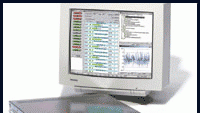TV network monitoring
It might seem like an eternity has passed, but it was less than 20 years ago that viewers around the world began to be offered multichannel television. While nobody at that time really knew what the implications of multichannel TV would be, every player in the broadcasting chain was soon benefiting.

The Tektronix MTM400 is a real-time MPEG transport stream monitor designed for use in centralized digital transmission networks.
Whereas subscribers could not believe their luck at having a 24-hour football channel, content production houses saw a multiplicity of new outlets hungry for content. Traditional broadcasters saw an opportunity to leverage their experience in content creation, TV equipment manufacturers could not cope with the new levels of demand, and, crucially, an untapped business opportunity had suddenly materialized for someone to carry the goods, i.e. the network operator.
It was not long before primitive conditional-access TV (CATV) family businesses gave way to multinational corporations with hundreds of thousands of subscribers. Neither was it long before cable stopped being the only platform via which multichannel TV could be transmitted, with first satellite and then digital terrestrial television (DTT) systems all fighting for a share of the booming pay-TV market.
Initially, all that network operators needed to care about was that the pace of their roll-outs was enough to keep up with subscriber demand. However, as soon as operators sensed that the market was reaching maturity and that they faced increasing competition from rival service providers, they realized that basing their business entirely on more content was not going to be enough. In order to guarantee customer loyalty, they needed to offer better content, not only in terms of more attractive programming, but in terms of providing a comprehensive and satisfactory viewing experience that included reception and picture-quality issues.
As the roll-out of digital TV gathers pace, quality of service (QoS) is increasingly becoming a vital requirement for network operators. Viewers have become used to high-quality pictures and become dissatisfied quickly when quality is compromised.
It only takes one bit
The professional video industry's #1 source for news, trends and product and tech information. Sign up below.
The need for QoS parameters is accentuated by the fact that current transmission architectures are so radically different to the analog days when, very often, the content producer was the same organization as the distribution and the transmission provider. In today’s digital environment, where the number of players and organizations directly involved in the handling of content has boomed, rarely a single TV program reaches a viewer without having first been formatted, copied, contributed, compressed, decompressed, modulated, demodulated, multiplexed, de-multiplexed, uplinked and down-linked dozens of times after it was initially captured by the camera. And it only takes one or two bits of data to be dropped at any of those digital transactions to get thousands of subscribers asking where the picture has gone. Timing and system information errors in the MPEG stream can fatally affect picture quality and cause re-multiplexing errors downstream.
In order for network operators to be able to guarantee transparent content reception, there is an evolving trend towards QoS-based service contracts with the various players involved in the transmission chain. This is not an issue that affects operators only. Steadily rising costs in content production also are driving broadcasters to demand the establishment of guaranteed QoS parameters throughout the transmission chain.
These demands are putting network monitoring under the spotlight. The only way that both broadcasters and service providers have of implementing QoS is through the deployment of network monitoring equipment at strategic points in the content distribution and transmission chain, but different content delivery platforms will have an impact on the level of sophistication that these network monitoring activities require. Digital satellite TV uplinks, for example, may have fewer points that require monitoring compared to a digital terrestrial network.
Current market trends
The roll-out of digital TV in Europe has yet to reach the scale that the industry has long envisioned. DTT is the platform that is expected to play a vital role in countries that are planning to switch off analog signals within the next decade, but it has been slow to take off. The UK, Finland, Sweden, Spain and now northeast Germany are on-air with DTT, while most other countries have plans to roll out similar services in the next few years.
In these relatively early days in terms of DTV infrastructure development, the main focus of current network monitoring activity is placed on the MPEG transport stream. Monitoring probes that can handle data rates of up to 155Mb/s can be deployed at key nodes of a DTT network, cable headend or DTH satellite uplink facility in order to isolate faults and perform a series of diagnostics on the health of the MPEG transport stream.
This helps protect the viewers from seeing digital artifacts caused by small stream errors triggering further problems along the chain. Warning of impending problems allows the engineers to diagnose and fix before anything is visible to the increasingly discerning viewers.
One particular trend that is currently shaping the world of network monitoring is that operators are demanding from their equipment the capability to monitor a number of parameters that are specific to their own services. This has resulted in the emergence of a new concept, template testing.
Products that incorporate this feature can check several key parameters to ensure that the transport stream is constructed as the broadcaster intended it to be. These parameters include the transport stream ID, network ID and the number of program in the multiplex. Another key feature of template testing is its ability to monitor conditional-access status and to monitor if each program has all of its components, such as video, audio, data, teletext and subtitles. As digital networks start to experience increasing subscriber numbers, they also will need to start monitoring other elements of their networks, such as the RF transmission, in order to ensure compliance with the specific parameters set out by the DVB standard. This multilayer approach to network monitoring is particularly important to consider in digital because problems in one layer can create more serious problems elsewhere.
Another major network monitoring issue that is likely to evolve in the near future concerns interactive TV software, for which specific MHP testing equipment will have to be brought in. As soon as Europe’s network operators begin to reach such an advanced stage of digital TV deployment, this type of monitoring equipment will form an integral part of the QoS mechanisms that will help them ensure that their most precious asset gets through, transparently, to the most important part of the network — the TV screen at home.
Paul Dubery is the European marketing manager for Tektronix Video Segment.
